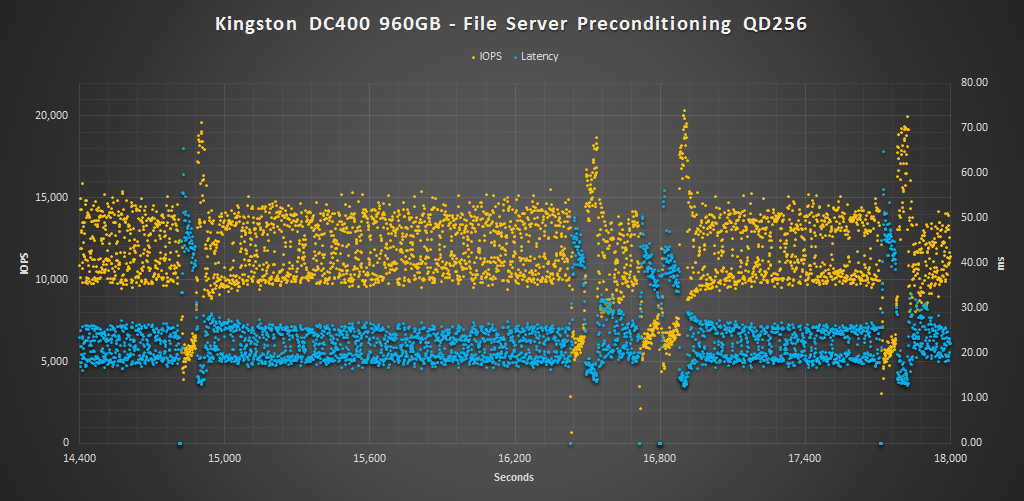SERVER PROFILES CONTINUED
Our last set of profiles includes both File Server and Web Server workloads. As mentioned before the last hour of preconditioning, the average IOPS, and average latency for each QD is graphed below.
The File Server profile is based on an 80% read/20% write mix. It’s made up of block sizes from 512 to 64K, each making up a different percentage of the access pattern. The pattern is: 512 bytes=10%, 1k=5%, 2k=5%, 4k=60%, 8k=2%, 16k=4%, 32k=4%, 64k=10%.
In this file server profile test the Kingston DC400 @800GB and Micron 5100 MAX are neck and neck, except the DC400 has better lower QD performance. The PM863 and HK4R, however, are better options here.
The Web Server profile is similar to the File Server profile, but has some additional 128K and 512K accesses thrown in for good measure. Additionally, the profile is 100% reads.
Finally, during the web server profile, we see that the DC400 is beat out where we were expecting it to do better. Form QD1-8 the 800GB over-provisioned model outperforms the Micron 5100 series, however, after that they take the lead.
 The SSD Review The Worlds Dedicated SSD Education and Review Resource |
The SSD Review The Worlds Dedicated SSD Education and Review Resource | 


There’s that word “plethora” again.
Edited it out for ya since I seem to use it too much for your liking, haha.
I think it was our E-I-C that didn’t care for it, lol!
Otherwise, for me it would be “Pot, meet Kettle!”
How do you call MLC flash and sequential reads at 560, and writes at 525, entry level for
sata 3? And if you overprovision it to 800 it now beats out its competition in other categories besides sequential. This sounds like it’s a lot better than entry level for sata 3?
I’m referring to it as entry-level due to it’s total performance as well as endurance and price-point in product line-ups in the enterprise market. Compared to other read-oriented SATA SSDs the Kingston at the same capacity typically offers the least performance and lowest endurance in comparison to other similar classed <1 DWPD products and it doesn't have power caps on it in case of a power outage liek others do, simply firmware protection instead. Thus, in comparison, this why I am referring to it as an entry level product. Once you move onto 1-3DWPD SATA SSDs you are now dealing with better performing drives that last longer, thus, not entry-level. Yes, while over provisioned to 800GB it was able to match or beat some of the competition, but it is at the expense of usable capacity. If you were to over provision those other SSDs, you would see similar improvements in performance. At that point it is a whole new comparison of price vs performance vs capacity vs endurance…in which case, with all things being equal, the Kingston may be at the lower end of the totem pole once again.
I see said the blind man.